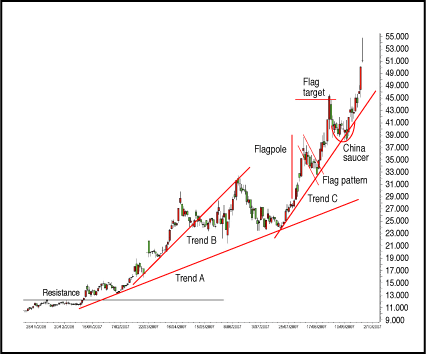Trend And Trend Behavior
Parallel Listings And True Price Value
In the second part of this series we continue to look at the differences in traders' perceptions by analyzing stocks listed in the Shanghai market and their counterpart listing in the Hong Kong market.
Trends and their behavior provide an analysis of longer-term market behavior. Chart patterns are a reflection of trading psychology and provide a range of high-probability outcomes. The patterns develop in response to traders' perceptions of opportunity. Although the link with fundamental developments may be more tenuous, we would still expect to see a similar pattern development in this parallel-listed stock. A range of different patterns confirms the importance of psychology in determining market pricing.
PATTERN TRADING
The Shanghai-listed Jiangxi Copper (Figure 1) shows a complex level of trend behavior and pattern development (note that all China stocks are shown with a China chart display: red = up). Trendline B defines the trend break starting in March 2007. This support line is broken in May 2007, and it provides a resistance point for the rally peak in June 2007.

FIGURE 1: PATTERN DEVELOPMENT IN SHANGHAI-LISTED JIANGXI COPPER. Note the trend and pattern developments.Trendline A is displayed for historical convenience. The two starting points in January and February 2007 are not confirmed until July 2007. This trendline is easy to plot retrospectively, but in real time it is more difficult.
Trendline C is a much more definite trendline. Projected from the starting point in July 2007, it can be used to manage a trend entry in August and early September. However, it is fair to conclude that trendline analysis is not the most effective way to define the trending behavior of Shanghai-listed Jiangxi Copper. Shorter-term trading opportunities are not well defined with this method.
The chart does contain two additional chart pattern features. The first is the flag pattern in August 2007. The flagpole measurement starts with the larger than usual range days starting July 30. The six-day rise creates a flagpole. The subsequent bullish flag develops over eight days. This is a classic bullish flag and a classic high-probability breakout. Prices move quickly to the target at 45.00 before retreating.
...Continued in the May issue of Technical Analysis of STOCKS &
COMMODITIES
Excerpted from an article originally published in the May 2008 issue
of Technical Analysis of
STOCKS & COMMODITIES magazine. All rights reserved. © Copyright
2008, Technical Analysis, Inc.
Return to May 2008 Contents